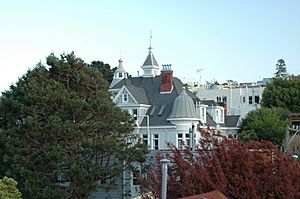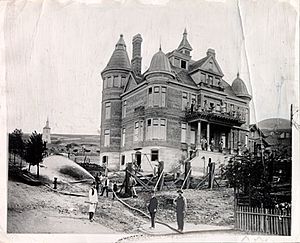Alfred E. Clarke Mansion facts for kids
Quick facts for kids Alfred E. Clarke Mansion |
|
|---|---|

The building in 2009
|
|
| Type | Mansion |
| Location | 250 Douglass Street, San Francisco, California, USA |
| Area | Eureka Valley, Castro District |
| Built | 1892 |
| Original use | Single-Family Residence (Hospital in early 1900s) |
| Architect | Alfred E. Clarke |
| Architectural style(s) | Baroque Queen Anne |
|
Invalid designation
|
|
| Official name: Alfred E. (Nobby) Clarke Mansion | |
| Designated | December 7, 1975 |
| Reference no. | 80 |
| Lua error in Module:Location_map at line 420: attempt to index field 'wikibase' (a nil value). | |
The Alfred E. Clarke Mansion, also known as the Caselli Mansion, is a large, historic house. It is located at 250 Douglass Street in San Francisco, California. Built in 1891 by Alfred "Nobby" Clarke, this impressive building has had many lives. It started as a family home, then became a hospital, and is now an apartment building. In 1975, it was officially recognized as a San Francisco Designated Landmark.
Contents
What Does the Clarke Mansion Look Like?
The Alfred E. Clarke Mansion is a four-story building. It is designed in a style called Baroque-Queen Anne. This style often includes fancy details and towers. The mansion has several towers and its roof features unique scalloped shingles. These shingles alternate with plain ones, creating a cool pattern.
The house stands at the top of Eureka Valley. It originally had 45 rooms inside. The interior is very grand, with an impressive entrance hall. There's a large staircase, beautifully carved fireplaces, and wood paneling. You can also find fine stained glass windows throughout the mansion. Alfred "Nobby" Clarke, who built the house, is said to have based its design on a French lakeside castle.
The History of the Clarke Mansion
Who Was Alfred "Nobby" Clarke?
Alfred "Nobby" Clarke came to San Francisco from Ireland in 1850. He started as a cabin boy. Later, he worked for the police department from 1856 to 1887. During this time, he became quite wealthy. He bought the land for the mansion in 1890. The house was finished in 1892 and reportedly cost $100,000 to build.
However, Clarke soon faced financial difficulties. He lost his money during a nationwide economic downturn. In 1892, he declared that he could not pay his debts. He tried to hide his properties by signing them over to his wife and a friend. He then started many lawsuits against the city and his creditors, but he did not win them. He eventually lost the mansion in 1896 because he couldn't pay his mortgage. His wife had preferred to live on Nob Hill, a more developed area, rather than the then-rural location of the mansion.
The Mansion's Many Lives
After Clarke lost the house, the California Medical College bought it. They used it as a teaching hospital. The building then became the Maclean Hospital and Sanitarium. This hospital taught a type of medicine called eclectic medicine. In 1900, Law Keem earned a medical degree there. This was the first medical degree given to a Chinese person in San Francisco.
The building was used for two more hospitals, including the California General Hospital in 1904. The mansion was even used as a hospital during World War I.
Surviving the Great Earthquake
Unlike many other Victorian mansions in San Francisco, the Clarke Mansion survived. It was not destroyed by the 1906 earthquake and the fires that followed. In 1909, it was converted into the Victor Apartments. This made it the first apartment building in its neighborhood, with 14 separate units. During World War II, Standard Oil leased the building. They used it to house their employees.
A San Francisco Landmark
The Alfred E. Clarke Mansion was officially named San Francisco city landmark number 80. This important designation happened on December 7, 1975. It helps protect the building's history and unique architecture for future generations.
Images for kids



